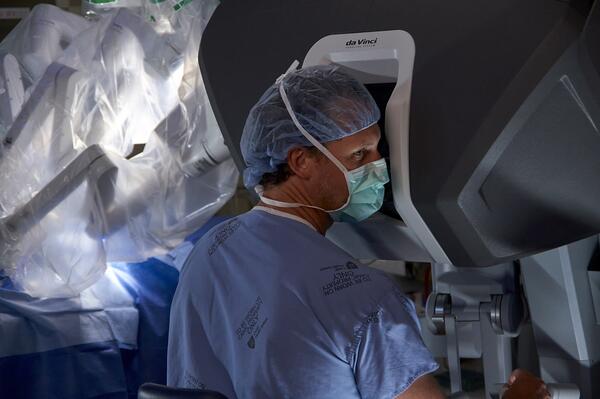Our Approach to Minimally-Invasive Surgery
Our board-certified physicians are recognized leaders who have introduced new surgical methods and perfected minimally-invasive techniques in nearly every type of surgery, from spine surgery and hernia repair to hysterectomy, cardiothoracic surgery, gallbladder surgery and orthopedic procedures.
As a Center of Excellence in Robotic Surgery, CAMC also offers the latest in minimally-invasive robotic-assisted surgery using the da Vinci Surgical System. The surgeon's hands control of this state-of-the-art robotic device to perform the most complex and delicate procedures through very small incisions with unmatched accuracy.
Patients undergoing gynecology procedures such as hysterectomy and fibroid removal; urology procedures such as prostatectomy and kidney and bladder surgeries; and many general surgery procedures such as bariatric, colon and hernia surgery, are potential candidates for da Vinci surgery.
Benefits of Minimally-Invasive Surgery
- Small incisions (cuts)
- Few stiches
- Shorter hospital stay
- Less pain
- Less scarring
- Less damage to healthy tissue
- Faster recovery (than traditional, open surgery)
Types of Minimally-Invasive Surgery
- Lap sleeve gastrectomy
- Lap Roux-en-Y bypass
- Lap Duodenal Switch
- EGD with Orbera Balloon
Watch a video from Dr. Antonios Chryssos, Cardio/Thoracic Surgeon
- VATS or robotic wedge resection
- VATS or robotic lobectomy
- Robotic esophagostomy
- Robotic thymictomy
- VATS or robotic mediastinal mass resection
- Robotic LIMA take down for MIDCAB
- Robotic heller myotome
- VATS decortication
- VATS pericardial window
- VATS epicardial lead placement
- Mitral valve repair
Watch a video from Dr. Edward Tiley, III General and Vascular Surgeon
- Thoracoscopic lung resection
- Thoracoscopic procedures for bronchial cysts, esophageal duplication
- Thoracoscopic procedures for spontaneous pneumothorax, empyema, diaphragmatic eventrations, chylothorax, mediastinal cysts and tumors
- Thoracoscopic Nuss procedure for pectus excavatum
- Laparoscopic fundoplication for GERD (gastroesophageal reflux disease)
- Laparoscopic heller myotomy for achalasia
- Laparoscopic gastric procedures for gastric duplications
- Laparoscopic pyloromyotomy
- Laparoscopic G-tube placement
- Laparoscopic small bowel procedures for malrotation, Intestinal duplications, feeding difficulties and enteral access, bowel obstructions
- Laparoscopic small bowel resection for Intussusception, meckels diverticulum, gastrointestinal bleeding, Crohn’s disease, intestinal stenosis, perforation
- Laparoscopic colon procedures for appendicitis, Crohn’s, ulcerative colitis, gastrointestinal bleeding, constipation, intestinal stenosis
- Laparoscopic rectopexy
- Laparoscopic pull through for Hirschsprung’s
- Laparoscopic management of tumors and intraabdominal abscesses
- Laparoscopic cholecystectomy for gallstone disease, biliary dyskinesia
- Laparoscopic splenectomy for spherocytosis, idiopathic thrombocytopenic purpura (ITP), diseases causing spleen destroying platelets and red blood cells
- Laparoscopic repair of hernias (abdominal wall, inguinal)
- Laparoscopic management of undescended testicles, Fowler-Stephens procedure
- Laparoscopic pyeloplasty for management of kidney obstruction
- Laparoscopic management of ureteral obstruction
- Laparoscopic management of ectopic ureters
- Laparoscopic nephrectomy
- Laparoscopic placement of peritoneal dialysis access
- Laparoscopic hiatal hernia repair
- Laparoscopic hernia
- Laparoscopic cholecystectomy
- EGC
- Colonoscopy
Watch a video from Dr. Gina Busch, Gynecologist
- Stereotactic and ultrasound guided breast procedures
- Hysterectomy
- Salpingo-Oophorectomy (removal of fallopian tubes and/or ovaries)
- Myomectomy (removal of fibroids without removing the uterus when future fertility is desired)
- Endometriosis surgery (surgical removal of an endometrioma and/or cauterization of endometrial implants)
- Gynecologic-oncology procedures for cervical or endometrial cancers
Watch a video from Dr. James Harman, Endovascular Surgeon
- Lumbar discectomy
- Lumbar decompression
- Lumbar foraminotomy
- Mini open lumbar inter body fusion (PLIF)
- Percutaneous pedicle screw placement
- XLIF minimally lateral lumbar inter body fusion
- ALIF
- Mini open trans-foraminal interbody fusion (TLIF)
- Cervical artificial disk replacement
- ACDF
- Sacroiliac joint fusion
- Use of intraoperative CT scan for image-guided spine surgery
- Closed Reduction Percutaneous Pinning (CRPP)
- Knee arthroscopy
- Shoulder arthroscopy
- Prostatectomy and pelvic lymph node dissection
- Radical/partial/simple nephrectomy
- Partial/radical cystectomy
- Nephrouretectomy
- Adrenalectomy
- Pyeloplasty
- Ureterectomy excision of the bladder cuff
- Robotic Prostatectomy with lymph node dissection
- Nephrectomy
- Nephroureterectomy
- Cystectomy
- Adrenalectomy
- Pyeloplasty
- TURP
- TURBT
- Ureterectomy
- Orchiectomy
- Lymphadenectomy
- Laser Lithotripsy
- Lithoalopaxy
- Renal biopsy
- Renal cyst decortication
da Vinci Surgical System at CAMC
The da Vinci Surgical System is a type of minimally-invasive surgery done at CAMC. As a Center of Excellence in Robotic Surgery, the da Vinci surgical team at CAMC has more doctors performing more procedures in more specialties than any other hospital in the state.
The da Vinci Surgical System is a laparoscopic surgical robot that integrates the latest advancements in robotics, computer-enhanced technology and the skills of surgeons.
The surgeon's hands are at the control of this state-of-the-art robotic device and can perform the most complex and delicate procedures through very small incisions, with unmatched accuracy.
The da Vinci surgical team at CAMC is specially-trained in efficiency to prepare for, assist with and complete robotic surgery cases. The CAMC team is used to demonstrate procedures and train new robotic teams from around the world.
Patients routinely travel to receive care at hospitals that offer robotic surgical technology. Since CAMC invested in this technology and now has two da Vinci systems, patients can stay close to home.

CAMC Minimally-Invasive Specialists
CAMC is home to some of the most experienced surgeons specializing in minimally-invasive procedures in West Virginia.


